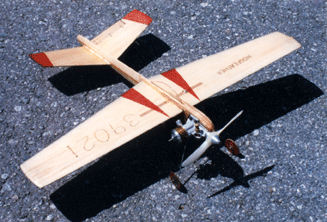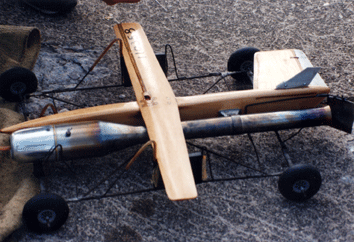
Greetings, Speedsters! It's about time for some speed talking, so here it is in no particular order or priority.
On the FL message board, Todd Ryan suggested we cover some info on minipipes.
 First off for the uninitiated who might not
understand what a minipipe is, here is a description of the basic exhaust
systems: The "full-wave" tuned pipe is what most folks associate
with speed planes. This is the long one with the double cone shape and has
the greatest potential for power increase, but also can be tricky to tune.
First off for the uninitiated who might not
understand what a minipipe is, here is a description of the basic exhaust
systems: The "full-wave" tuned pipe is what most folks associate
with speed planes. This is the long one with the double cone shape and has
the greatest potential for power increase, but also can be tricky to tune.
Not seen very often, is the "megaphone" pipe, which looks like a full tuned pipe cut off at the maximum diameter. These are technically only legal in the speed classes that allow full tuned pipes. They supposedly work on a half-wave principle, but I suspect they are not very efficient. Could be wrong about that, but not wrong about the fact that they are very loud!
Photo: SuperTigre X-29-powered Class B Speed plane by the late ron Salo. Mike Hazel photo.
And then there is the minipipe, which is a constant diameter pipe for the exhaust to exit. These work on a "quarter-wave" principle. Oops, guess there is a fourth exhaust system, that of open exhaust meaning no extension piping!
Some history: As most of you know the team of Theobald and Wisniewski pioneered use of full wave tuned pipes in competition speed planes back in the mid 1960's. The other pipe styles came later, and not really sure who and exactly when.
I do remember reading somewhere that a speed guy, possibly from one of
the Carolinas, noted that the tuned pipe exhaust elbow all by itself seemed
to give some performance boost over open exhaust. This was sometime
around 1970 or so (emphasis  on the or so), and the
popular 15, 29 and 65 size engines of the time were the side exhaust Super
Tigres. There were ST exhaust elbows for those who wanted to include
a tuned pipe as part of the package. Anyhow, as the story probably
goes, one guy adds a straight pipe to the exhaust elbow and gets a nice
little power boost without the fuss and bother of the full pipe. If
anybody can fill in some more points of this history, please do so.
on the or so), and the
popular 15, 29 and 65 size engines of the time were the side exhaust Super
Tigres. There were ST exhaust elbows for those who wanted to include
a tuned pipe as part of the package. Anyhow, as the story probably
goes, one guy adds a straight pipe to the exhaust elbow and gets a nice
little power boost without the fuss and bother of the full pipe. If
anybody can fill in some more points of this history, please do so.
Anyway, in these earlier days the full tuned pipes were legal in all classes. In the brand new Formula 40 event there were even some entries that sported full pipes. This was soon legislated away, and the .65 class also went that way at some point. If I drug out all the old rule books, we could find out the year but I suspect one of you knows right off the top of your head.
Photo: Mike Hazel's Hogfeather 1/2-A proto from about 1997. Engine is a Stels .049. ZZ Prop propeller, ultralight plywood/carbon fiber wheels. Mike Hazel photo.
When I started speed flying back in 1974 (sounds like a long time ago, eh?), I started with a ST G15 for class A, and a ST 29RV ABC for class B. These were both side exhaust engines, and were fitted by minipipes that were made by George Aldrich. What George did was to machine a piece of aluminum pipe that was press-fitted into the Super Tigre exhaust elbow unit.
 OK already, you are saying ... enough history, how do we
set these minipipes up and how do they work? Well OK, I'll tell you
... I don't know. There has been technical information published on
this subject, which gives some detail and honest to goodness equations and
formulas on calculating all of this. I believe this was included in
Tim Gillott's engine rework article that was in Speed Times newsletter a
couple of years ago. And it has been covered elsewhere before as well,
let's not get into formula stuff now because it makes my head hurt.
OK already, you are saying ... enough history, how do we
set these minipipes up and how do they work? Well OK, I'll tell you
... I don't know. There has been technical information published on
this subject, which gives some detail and honest to goodness equations and
formulas on calculating all of this. I believe this was included in
Tim Gillott's engine rework article that was in Speed Times newsletter a
couple of years ago. And it has been covered elsewhere before as well,
let's not get into formula stuff now because it makes my head hurt.
Suffice to say that there is an ideal length and diameter for the minipipe. The length is obviously tied to the engine RPM, and the diameter would have some relationship with engine "volume." Methinx the length is somewhat critical, but I suspect that the diameter is much less so, as I have seen different pipe sizes over the years. I remember once seeing a minipipe on a .65 size engine that was scarcely larger than the standard size for a .40. The owner remarked that he needed to try a larger diameter pipe, as he believed the size he had was creating some back pressure and choking the exhaust. With this anecdote, it sounds like it is best to err on the large side.
Photo: Speed pits in Eugene circa 1993-94. Mike Hazel photo.
The other critical point of operation like all pipes is to make sure that it is leak-free. This would mean to have a good seal at the header junction. OK, that's all we are going to cover on the subject for now. Comments welcome to let me know what I missed, and if I am full of baloney.
******************************************************************
One thing that we speed folks do not have available to us is a one-stop
speed shop. How many of you remember "Bill's Miniature Engines,"
the mail order hobby shop back on the East Coast?  This
was operated by William McGraw, and featured all manner of speed goodies:
Hardware, control units, wood, pans, engines and rework, and the Speedmaster
line of products which included the Kansas Twister kits, and those neato
monoline swivel handles. Well, maybe they didn't have everything but
today it seems that if you need 10 different things, you go to ten different
places for them.
This
was operated by William McGraw, and featured all manner of speed goodies:
Hardware, control units, wood, pans, engines and rework, and the Speedmaster
line of products which included the Kansas Twister kits, and those neato
monoline swivel handles. Well, maybe they didn't have everything but
today it seems that if you need 10 different things, you go to ten different
places for them.
Nitro shortage? That seems to be the word on the Internet. According to the information there, our Chinese connection is temporarily down and supplies are low. Guess we will soon see if this really affects our activity.
Photo: Clockwise jet speed plane by the late Doc Davis, probably from Roseburg Regionals. Mike Hazel photo.
Seattle area speed site? Scott Newkirk sez he is trying to find one, now that the facility at Clover Park College is no longer available. Would be nice to have another site to support the activity up in the area that used to be a hotbed.
In the timeframe of 1997 to 2001, I used to put out a little regional newsletter called the "Northwest Speed Flyer." I am considering ressurecting this publication in the near future. While we have this here fine web site and all, some folks don't do the Internet, and some that do sometimes forget. The content would primarily be a repeat of this column, plus a couple of other tidbits thrown in. There would be no cost involved to the recipients as it would also be an advertising arm for the business end of Zoot Zoomer enterprises. Let me know if you would be interested.
All for now, Fly Fast!
This page was upated June 18, 2008